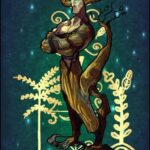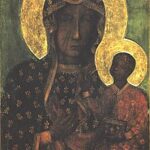Maman Brigitte is a significant figure in Vodou mythology, representing the intersection of African traditions and the spiritual beliefs that evolved in the Caribbean, particularly in Haiti. She is often regarded as the goddess of the dead and is associated with the afterlife. Maman Brigitte embodies both the nurturing and protective aspects of motherhood, as well as the formidable power of death. Her presence in Vodou rituals is essential, as she serves as a mediator between the living and the dead. This article delves into her origins, attributes, and the rituals associated with her, providing a comprehensive understanding of her role in Vodou culture.
Origins of Maman Brigitte
The origins of Maman Brigitte can be traced back to the syncretism of African and European beliefs. She is often identified with the Celtic goddess Brigid, who is associated with fire, healing, and poetry. This connection highlights the blending of cultures that occurred during the transatlantic slave trade. Enslaved Africans brought their spiritual beliefs to the Caribbean, where they merged with the indigenous and colonial practices. Maman Brigitte emerged as a powerful figure, representing both the ancestral heritage of the African people and the influences of European mythology.
 Ghede
GhedeMaman Brigitte is also considered a lwa or spirit in Vodou, specifically linked to the dead. In Vodou, the lwa are intermediaries between humans and the supreme being, Bondye. Maman Brigitte is particularly revered in rituals that honor the deceased, as she is believed to have the power to guide souls to the afterlife. Her dual identity as both a protector and a guide makes her a central figure in the Vodou pantheon.
Attributes and Symbols
Maman Brigitte is often depicted with distinct attributes that symbolize her power and influence. She is usually portrayed with dark skin, which represents her connection to the earth and the ancestors. Her appearance often includes a skull, reflecting her role as a guardian of the dead. Additionally, she is associated with the color black, which signifies both mourning and the mystery of death.
In Vodou practices, Maman Brigitte is often linked to various symbols that reinforce her connection to the afterlife. For example, crosses and bones are commonly used in rituals dedicated to her. These symbols serve as reminders of the transient nature of life and the importance of honoring those who have passed. Maman Brigitte is also associated with fire, which represents transformation and purification. This element highlights her ability to guide souls through the process of death and rebirth.
 Grand Bois
Grand BoisRituals and Offerings
Rituals dedicated to Maman Brigitte are vital in Vodou ceremonies, especially those that focus on the deceased. These rituals often involve offerings that reflect her preferences. Common offerings include rum, cigars, and food, particularly dishes that the deceased enjoyed in life. The act of making these offerings is a way to show respect and to invite Maman Brigitte’s presence into the ceremony.
During Vodou ceremonies, practitioners often invoke Maman Brigitte through songs, prayers, and dance. The ritual drumming plays a crucial role in calling her spirit, creating an atmosphere that allows for communication between the living and the dead. Participants may also dress in black or wear symbols associated with Maman Brigitte to honor her during these rituals.
Common Offerings for Maman Brigitte
- Rum: A favored drink that is often poured as an offering.
- Cigars: Symbolic of respect and a way to connect with the spirit world.
- Food: Dishes that the deceased enjoyed are often prepared and presented.
- Flowers: Particularly marigolds, which are associated with the dead.
These offerings are not only a means of honoring Maman Brigitte but also serve as a way to maintain a connection with the deceased. The belief is that by appeasing Maman Brigitte, the spirits of the dead are more likely to find peace and guidance in the afterlife.
 Erzulie Freda
Erzulie FredaMaman Brigitte in Popular Culture
Maman Brigitte has also made her mark in popular culture, often depicted in literature, film, and music. Her representation in these mediums serves to highlight the complexities of Vodou and its practitioners. Maman Brigitte’s character is frequently portrayed as a strong, independent woman who commands respect and fear. This portrayal aligns with her role in Vodou as a powerful protector of the dead.
In literature, Maman Brigitte is often referenced in works that explore themes of death, spirituality, and cultural identity. Authors may draw upon her attributes to illustrate the struggles of individuals navigating their cultural heritage. Her presence in stories serves as a reminder of the importance of honoring one’s ancestors and understanding the spiritual world.
Examples of Maman Brigitte in Popular Culture
- Literature: References in novels that explore Vodou themes.
- Film: Depictions of Vodou practices that include Maman Brigitte.
- Music: Songs that celebrate her strength and connection to the dead.
These cultural representations contribute to the broader understanding of Vodou and challenge misconceptions that often surround the religion. By showcasing Maman Brigitte’s power and significance, artists and writers help to preserve the rich traditions associated with Vodou mythology.
Maman Brigitte and Feminine Power
Maman Brigitte stands as a symbol of feminine power within Vodou. Her character embodies the strength, resilience, and nurturing qualities often associated with motherhood. In a society where women have historically been marginalized, Maman Brigitte represents the empowerment of women in spiritual practices. Her influence in Vodou rituals emphasizes the importance of women’s roles in maintaining cultural traditions and spiritual connections.
The worship of Maman Brigitte also highlights the significance of women as mediators between the spiritual and physical worlds. Women in Vodou communities often take on the role of priestesses or leaders, guiding rituals and ensuring the proper honoring of the lwa. This aspect of Vodou emphasizes the essential contributions of women in preserving cultural identity and spiritual practices.
Attributes of Feminine Power in Maman Brigitte
- Strength: Represents resilience in the face of adversity.
- Nurturing: Acts as a mother figure for the dead and the living.
- Guidance: Provides support and direction for souls in the afterlife.
Maman Brigitte’s role as a powerful female figure encourages a deeper understanding of the dynamics within Vodou and the respect afforded to women in these spiritual practices. Her presence serves as a reminder of the strength found in femininity and the importance of honoring the contributions of women in all aspects of life.
Contemporary Practices and Beliefs
In contemporary Vodou practices, Maman Brigitte remains a central figure for many practitioners. Her rituals continue to evolve, adapting to the changing cultural landscape while retaining their core significance. Modern Vodou practitioners often blend traditional rituals with contemporary elements, ensuring that the worship of Maman Brigitte remains relevant in today’s society.
Many Vodou practitioners today focus on community and healing, with Maman Brigitte playing a pivotal role in these efforts. Her association with death and the afterlife is often intertwined with themes of healing and transformation. This holistic approach reflects a broader understanding of spirituality, where the emphasis is placed on the interconnectedness of life and death.
Modern Rituals Involving Maman Brigitte
- Community Gatherings: Rituals that emphasize collective healing and support.
- Memorial Services: Honoring the deceased with Maman Brigitte’s guidance.
- Workshops: Teaching the significance of Vodou and the role of Maman Brigitte.
These modern practices reflect a desire to maintain cultural heritage while addressing contemporary issues. By honoring Maman Brigitte, practitioners seek to create a space where spirituality can flourish, fostering a sense of community and connection among individuals.
The Significance of Maman Brigitte in Vodou
Maman Brigitte’s significance in Vodou extends beyond her role as a goddess of the dead. She represents the cultural identity of the Haitian people, embodying their struggles, resilience, and connection to their ancestors. Her worship serves as a means of preserving cultural traditions and fostering a sense of belonging among practitioners.
The rituals and beliefs surrounding Maman Brigitte also highlight the importance of memory and remembrance in Vodou. By honoring the dead and invoking Maman Brigitte, practitioners create a space for reflection and healing. This aspect of Vodou emphasizes the belief that the past is never truly gone; it continues to influence the present and shape the future.
Key Themes in Maman Brigitte’s Worship
- Memory: Honoring ancestors and preserving cultural heritage.
- Community: Fostering connections among practitioners and their families.
- Healing: Addressing emotional and spiritual needs through rituals.
Maman Brigitte’s worship serves as a powerful reminder of the importance of cultural identity and the ongoing connection between the living and the dead. Her presence in Vodou rituals reinforces the belief that spirituality is a communal experience, rooted in shared traditions and collective memory.
